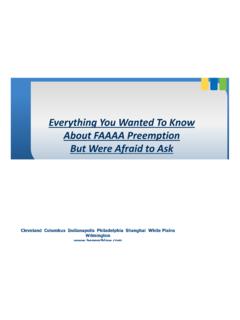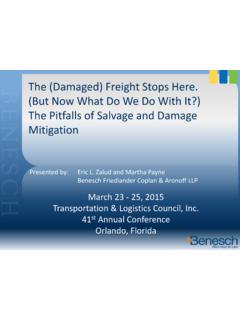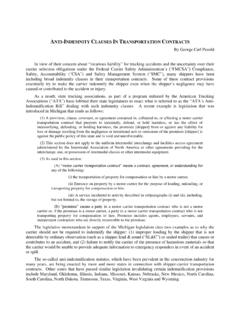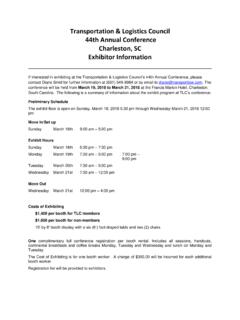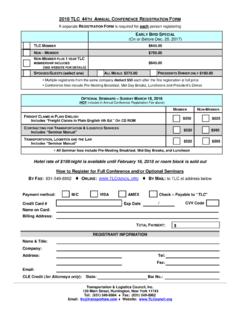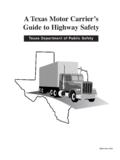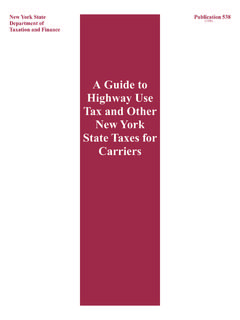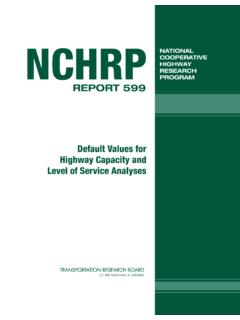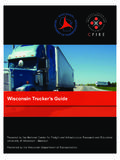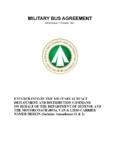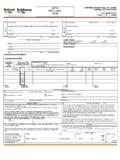Transcription of SPECIAL REPORT - The Transportation and Logistics …
1 SPECIAL REPORT . NMFTA CHANGES THE UNIFORM STRAIGHT BILL OF LADING! By George Carl Pezold Executive Director Background: The Uniform Straight Bill of Lading has been around for almost one hundred years. Following unsuccessful efforts by the rail industry to reach agreement on uniform bills of lading, in 1919. the Interstate Commerce Commission ("ICC") prescribed the forms of bills of lading for domestic and export shipments. Over the years, the ICC considered various changes to the bills of lading, and the forms of the current rail bills of lading are now found in the Surface Transportation Board ("STB") regulations at 49 CFR 1035. Motor carriers were treated differently. The ICC never prescribed forms for motor carrier bills of lading. The motor carrier version was drafted by shippers and carriers and approved by the ICC. in 1922, and was not materially changed until December of 1997. Enactment of the Trucking Industry Regulatory Reform Act of 1994 ( TIRRA ) and the ICC.
2 Termination Act of 1995 ("ICCTA") disrupted the previous system of incorporation of filed tariffs and classifications by reference in the bill of lading. However, the introductory language of the uniform bill of lading still referred to lawfully filed tariffs". Repeated efforts were made to eliminate the reference to lawfully filed tariffs in the uniform bill of lading, but each time the proposed changes were suspended by the ICC or by its successor, the STB, in Docket 35000, and did not go into effect. Following these attempts to revise the uniform bill of lading, the National Motor Freight Traffic Association approached the National Small Shipments Traffic Conference and formed an ad hoc committee consisting of six representatives each from the NCC and NASSTRAC. The committee was able to reach a compromise agreement on a number of changes to the uniform bill of lading, The STB issued its decision in Docket 35002, December 19, 1997, allowing the new uniform bill of lading to go into effect, and it was published in Supplement 3 to STB NMF.
3 100-X, which became effective on December 27, 1997, The current version of the Uniform Straight Bill of Lading, and the Terms and Conditions on the reverse side have been virtually unchanged for the last 19 years. On July 14th, the National Motor Freight Traffic Association (NMFTA), publishers of the National Motor Freight Classification (NMFC), issued Supplement 2 to NMF 100-AP, effective August 13, 2016. This Supplement contains changes to the bill of lading forms - the Uniform Straight Bill of Lading, including the Terms and Conditions on the reverse side, and the Straight Bill of Lading- Short Form, as well as to the NMFC rules in Item 360 - Bills of Lading, Freight Bills and Statements of Charges. The changes to the bill of lading were made without notice to the public, nor were shippers given any opportunity to comment, or to protest the changes. Impact of the changes: The Uniform Straight Bill of Lading and the Straight Bill of Lading - Short Form are widely used by shippers, freight forwarders, brokers and 3PL's that tender freight to motor carriers.
4 Unless other arrangements are made between the parties, such as a formal Transportation contract, carriers that are participants in the NMFC are required to use these bills of lading, which incorporate the provisions of the Classification, as well as the carrier 's rate and rules tariffs by reference, and are generally binding on the parties. NMFC Item 362-B states: Unless the shipper and carrier have an effective prior written agreement to use another bill of lading, all motor carriage performed by carriers participating in this tariff shall be subject to the bill of lading terms and conditions of the Uniform Straight Bill of Lading shown in NMF 100-X and successive issues. Unfortunately, many shippers (and even their attorneys) have never read the terms and conditions on the reverse side of the Uniform Straight Bill of Lading or are only vaguely familiar with them. These changes significantly change the provisions governing carrier liability for loss, damage or delay and time limits for filing claims.
5 Here are the most serious of the new terms and conditions: Section 1.(a) of the "old" bill of lading provided as follows: Sec. 1. (a) The carrier or the party in possession of any of the property described in this bill of lading shall be liable as at common law for any loss thereof or damage thereto, except as hereinafter provided. Section 1.(a) of the "new" bill of lading provides as follows: Sec. 1. (a) The carrier shown as transporting the property described in this bill of lading shall be liable as at common law for any loss or damage to the shipment, except as provided herein. Comment: The old language made it clear that the carrier "in possession" of the goods would be liable for loss or damage. The new language only refers to the carrier "shown" on the bill of lading, which raises the question: What if the actual carrier in possession of the goods at the time of the loss or damage is not the carrier "shown" on the bill of lading? This could be because the name of the actual carrier was not inserted in the space on the face of the bill of lading (often shippers insert the name of the broker or intermediary), or if the loss or damage occurs while the goods are in the possession of a connecting or delivering carrier on an interlined shipment.
6 The new language would imply that a carrier that is not "shown" on the bill of lading would not have liability for loss or damage. Section 1.(b) of the "old" bill of lading provided: (b) No carrier shall be liable for any loss or damage to a shipment or for any delay caused by an Act of God, the public enemy, the authority of law, or the act or default of shipper. Except in the case of negligence of the carrier or party in possession, the carrier or party in possession shall not be liable for loss, damage or delay which results: when the property is stopped and held in transit upon request of the shipper, owner or party entitled to make such request; or from faulty or impassible highway, or by lack of capacity of a highway bridge or ferry; or from a defect or vice in the property; or from riots or strikes. The burden to prove freedom from negligence is on the carrier or the party in possession. Section 1.(b) of the "new" bill of lading contains the most egregious of the changes, which change the legal burdens of proof: {b) No carrier shall be liable for any loss or damage or for any delay caused by an Act of God, the public enemy, the authority of law, the act or default of the shipper, riots or strikes, or any related causes.}
7 Except in the case of negligence of the carrier , the carrier shall not be liable for loss, damage or delay which results: when the property is stopped and held in transit upon request of the shipper, owner or party entitled to make such request; or from faulty or impassible highway, or by lack of capacity of a highway, bridge or ferry; or from a defect or vice in the property. The burden to prove carrier negligence is on the shipper. Comment: There are two significant changes in the new language. First, it adds "riots or strikes or any related causes" to the list of the common law defenses to carrier liability. But, more importantly it shifts the carrier 's burden for proving freedom from negligence, to the shipper who now must prove that the carrier was negligent! These changes are contrary to over a century of law involving the interpretation and application of the "Carmack Amendment", now codified at 49 USC 14706. As the Supreme Court stated in Missouri Pacific Co.
8 V. Elmore & Stahl, 337 134 (1964)..a carrier , though not an absolute insurer, is liable for damage to goods transported by it unless it can show that the damage was caused by '(a) the act of God; (b) the public enemy; (c) the act of the shipper himself; (d) public authority; (e) or the inherent vice or nature of the ' Accordingly, under federal law, in an action to recover from a carrier for damage to a shipment, the shipper establishes his prima facie case when he shows delivery in good condition, arrival in damaged condition, and the amount of damages. Thereupon, the burden of proof is upon the carrier to show both that it was free from negligence and that the damage to the cargo was due to one of the excepted causes relieving the carrier of liability.. The reasoning for not requiring the shipper to prove negligence is obvious. When the shipper tenders his goods to the carrier he doesn't "ride shotgun" with them. He has no way to know what the carrier does with the goods, so it would be virtually impossible for the shipper to prove that the cause of the loss or damage was the carrier 's "negligence", for example, which party may have caused an accident or whether the carrier failed to adequately protect the goods from theft by a third party.
9 Moreover, the addition of a negligence standard runs counter to the strict liability standard implemented by the Carmack Amendment ( , good condition at origin, damaged condition at destination and the amount of damages). Indeed, one of the core principles behind the enactment of the Carmack Amendment was to do away with forcing shippers to prove a carrier was negligent for the reasons stated above. As such, this new provision is unconscionable and clearly contrary to the Carmack Amendment Section 1.(b) of the "old" bill of lading provided: Sec. 2. Unless arranged or agreed upon, in writing, prior to shipment, carrier is not bound to transport a shipment by a particular schedule or in time for a particular market, but is responsible to transport with reasonable dispatch. In case of physical necessity, carrier may forward a shipment via another carrier . Section 2. of the "new" bill of lading provides: Sec. 2. Unless arranged or agreed to in writing or electronically, prior to shipment, carrier is not bound to deliver a shipment by a particular schedule or in time for a particular market, but will transport the shipment in the regular course of its providing Transportation services.
10 In the case of physical necessity while in transit, carrier may forward the shipment via another carrier . Comment: Here the NMFTA has changed the established standard, recognized and applied by the courts for a century, which define the carrier 's duty to deliver with "reasonable dispatch". As the Supreme Court stated in New York, P. & N. R. Co. v. Peninsula Produce Exch. of Maryland, 240 34 (1916): ..It is said that there is a different responsibility on the part of the carrier with respect to delay from that which exists where there is a failure to carry safely. But the difference is with respect to the measure of the carrier 's obligation; the duty to transport with reasonable despatch (sic) is none the less an integral part of the normal undertaking of the carrier .". Section 3.(b) of the "old" bill of lading provided as follows: (b) Claims for loss or damage must be filed within nine months after the delivery of the property (or, in the case of export traffic, within nine months after delivery at the port of export), except that claims for failure to make delivery must be filed within nine months after a reasonable time for delivery has elapsed.
